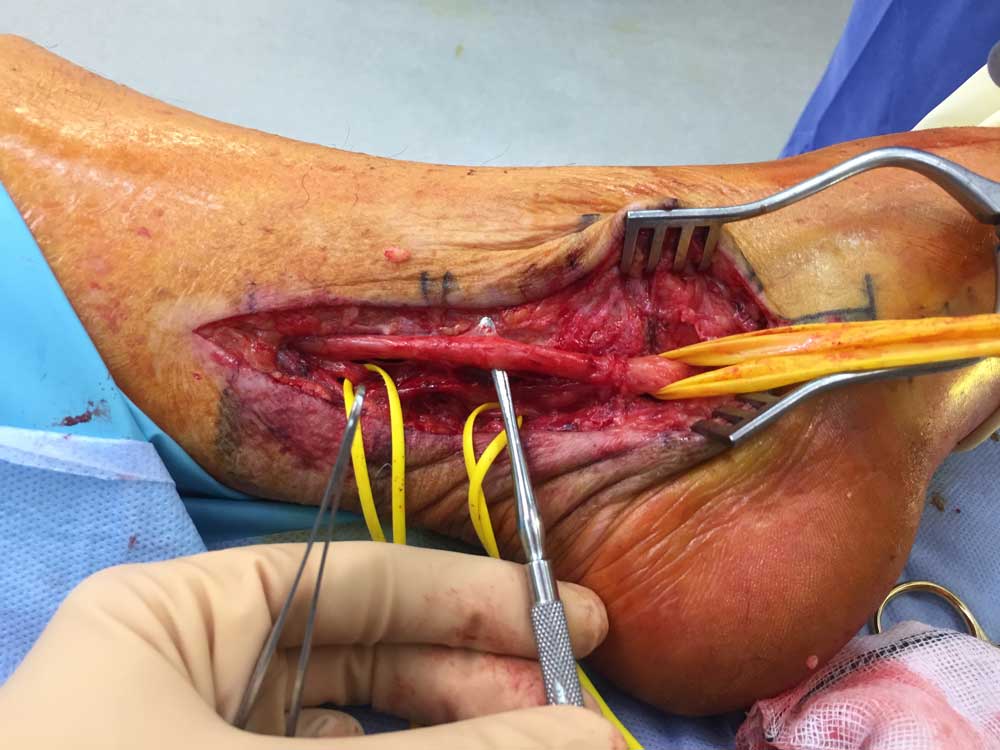What Is the Tarsal Tunnel?
The tarsal tunnel is a narrow space found on the inside of the ankle next to the ankle bone. It’s covered by the flexor retinaculum, a thick ligament that protects and maintains the arteries, veins, tendons, and nerves that run through it. Among those protected nerves is the posterior tibial nerve.
What is Tarsal Tunnel Syndrome?
This ongoing condition occurs when the posterior tibial nerve is compressed or squeezed anywhere along the tarsal tunnel from the inside of the ankle into the foot.
What are the Symptoms of Tarsal Tunnel Syndrome?
Tarsal Tunnel Syndrome may develop over time or appear suddenly. Patients experience:
- Sensations similar to an electrical shock
- Numbness
- Tingling
- Burning
- Shooting pain
Symptoms generally affect the bottom of the foot and the inside of the ankle. They may extend to the arch, toes, heels, and even the calf.
What Causes Tarsal Tunnel Syndrome?
A variety of factors, alone and together, can contribute to the development of tarsal tunnel syndrome and the compression of the tibial nerve:
- Flat feet
- Previous injury to the ankle
- Prolonged standing
- Varicose veins
- Diseases (such as diabetes), or those that trigger swelling
- Tumours
- Inflammatory diseases (such as rheumatoid arthritis)
When Should I Consult a Doctor?
Nerve disorders in the leg can go from bad to worse if left untreated. Consult your doctor promptly if:
- You have trouble standing
- Your foot and ankle are in pain
- You feel shock-like electrical impulses in your lower leg and foot
- Your ankle or foot feel numb
- Pain that worsens after exercise
A consultation with your doctor will help you determine whether tarsal tunnel syndrome is the cause of your pain. Early diagnosis can lead to a more beneficial treatment outcome.
How Is Tarsal Tunnel Syndrome Diagnosed?
During a physical examination, your doctor will take your medical history, perform a physical exam, and assess your symptoms. You will likely undergo a Tinel’s test which consists of a light tapping on the posterior tibial nerve.
Beyond these in-practice tests, other diagnostics may be necessary. Their goal is to illuminate the condition of the tarsal tunnel and tibial nerve more fully and test the condition of electrical impulses within the nerve.
- Electromyogram
- Nerve conduction studies
- MRI
The tests are minimally invasive and well tolerated by the majority of patients.
What are the Treatments for Tarsal Tunnel Syndrome?
With the help of test results, a customised treatment plan can be created based on the cause and severity of the nerve injury. Initially, recommendations may include:
- Rest
- Keeping the leg elevated
- Over-the-counter pain medication
The next level of treatment might be:
- Corticosteroid injections
- Prescription medication
- Splint
- Brace
When conservative treatments are not sufficient to alleviate symptoms and if the symptoms are severe, or if diagnostic tools reveal a significant injury, surgery may be required.
What is Tarsal Tunnel Surgery?
Tarsal tunnel surgery is an operation designed to restore sensory function to the foot and ankle by relieving pressure on the tibial nerve. One study notes an 80% success rate with surgical decompression. (Surgical results are more positive in cases where there is a well-defined mass causing the compression. The outcome is less reliable in other circumstances.)
The surgery is performed with general anaesthesia to ensure patient comfort. It’s completed within one hour and patients go home the same day. An incision is made on the inner side of the ankle. This incision allows Dr Sammons to view, access, and free the tibial nerve. The incision is closed with dissolving stitches that are absorbed by the body.
What Can I Expect after Tarsal Tunnel Surgery?
When your procedure is complete, you will be taken to an observation room and monitored during your recovery. When you wake up, you will likely feel drowsy. Your incision will be bandaged, and you may feel pain or it may feel numb. It depends on how your body processes the anaesthesia. You will be asked to perform some simple tasks, including moving the foot. When it is deemed appropriate, you will be given post-surgical guidelines and released into the care of your family member or friend to take you home.
What Should I Do After Tarsal Tunnel Surgery?
You will receive a set of guidelines to help you with self-care at home. Be sure to follow them as doing so can significantly improve your recovery in both the short and long term. Among the things you may be asked to do:
- Monitor your progress. Contact Dr Sammons immediately should you experience increased swelling, more pain, or a fever.
- Keep your leg elevated for the first few days, to reduce swelling
- Keep your bandage on for one week
- Refrain from getting the foot wet for 7 days.
- Resume normal everyday activities, including walking, after one week
- Resume running after six weeks
Your age, overall health, and especially the nature of your nerve compression are all factors in how long recovery will take. Surgical symptoms will improve quickly, but it may take nerves up to a year to regain their full function.
When Will I Follow Up with Dr Sammons?
Dr Sammons will work with you throughout your recovery. Your first follow-up will occur approximately 6 weeks after surgery. A practice nurse will contact you within 7 days of your procedure to schedule your visit and to answer any questions. Should you have any concerns or need information about any aspect of your recovery, call Dr Sammons for guidance.
Does Tarsal Tunnel Syndrome Come Back?
Surgery to alleviate tarsal tunnel syndrome has a high success rate. The majority of patients regain a full range of motion and normal sensation, depending on the severity of their injury. A small number of individuals experience a persistence of symptoms.
Please call our rooms if you have any additional concerns or questions.
